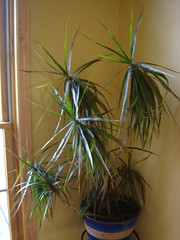Ann, our Perennials Manager here at The 'Bin attended a the Front Range Fruit Growing Symposium this last weekend. The staff here at The 'Bin continue to take classes and stay up to date on the most recent horticulture trends and developments, so we can continue to be experts in our field! Take a look to get a brief idea of the things Ann got to learn about this weekend. Have a question for her? Feel free to shoot us a Facebook message, call us or stop in today!
In Ann's words...
FRONT RANGE FRUIT GROWING SYMPOSIUM
Last weekend, I went to The Front Range Fruit Growing Symposium. It was held at Silver Creek High School, and organized by Dr. Joel Reich of Colorado State Extension – Boulder County, and sponsored by: Nourse Farms and Cummins Nursery, (plant suppliers), Mad Greens (donated an excellent lunch), and Sprouts (refreshments and snacks). There were 1 ½ days of presentations and a ½ day apple grafting class. It was aimed at all levels of fruit growing enthusiasts, from someone with one tree in their yard to commercial growers.

Speakers included: Walt Rosenberg of Masonville Orchards, with multiple sites on the Front Range, Tim Ferrel of Berry Patch Farms in Brighton, Pete Tallman, a local berry breeder , specializing in Black Raspberries, Scott Skogerboe, Head Propagator of Ft. Collins Wholesale Nursery, Irene Shonle of CSU Extension -Gilpin County, Harrison Hughes from the CSU Dept. of Horticulture, Joel Reich from CSU Extension-Boulder County, Whitney Cranshaw of CSU Dept. of Bioagricultural Sciences, Andy Hough, Director of Agricultural Resources-Douglas County.
Walt Rosenberg of Masonville Orchards, and Tim Ferrel of Berry Patch Farms spoke about the challenges of growing fruit in our climate, and the hazards of running an orchard business.
Pete Tallman spoke of his 20 year adventure of finding, developing, and patenting, a first year fruiting,
primocane, black raspberry called ‘Explorer.’
Scott Skogerboe, Head Propagator of Ft. Collins Wholesale Nursery has an amazing hobby, researching, and propagating ancient apple varieties. He has resurrected Johnnie Appleseed’s last living apple tree, and the tree that “inspired” Isaac Newton’s ideas about gravity, among others. These pieces of history live on, though not too available commercially. His talk was titled “Eat a Piece of History:
Growing Historic Fruit Trees in Colorado.”
Irene Shonle, of CSU Extension -Gilpin County, spoke about native plants and the quality of their fruit. Serviceberry, Golden Currant, Buffaloberry, etc. wild strawberry…. and what not to eat!
Harrison Hughes from the CSU Dept. of Horticulture and Joel Reich from CSU Extension-Boulder County, added sources of more information and opportunities to have hands-on volunteer adventures in orchards and vineyards. Dr. Reich also showed us examples of pruning techniques to promote fruit production on apples and peaches.
Andy Hough, Director of Agricultural Resources-Douglas County spoke about ongoing research occurring near Franktown on field and high tunnel production of fruits and berries.
Whitney Cranshaw of CSU Dept. of Bioagricultural Sciences came with lots of bug slides, and great enthusiasm for the infestations that he promotes in his own yard….so he can get those slides! Dr. Cranshaw’s slides and handout are at:
We did have one speaker who couldn’t make it due to the weather, it snowed, remember, yahoo! This was our new Fruit Specialist from CSU, Amaya Atucha. Her handout is on the Boulder County Extension page above.
Now, our county Extension Agents have a wealth of information for you, too. Besides these handouts, there are webinars, and lots more!
~~~~~~~~~~~~~~~~~~~~~~~~~~~~~~~~~~~~~~~~~~~~~~~~~~~~~~~~~~~~~~~~
Thanks for taking a peek...like we said earlier, don't hesitate to contact us for further questions!






















































